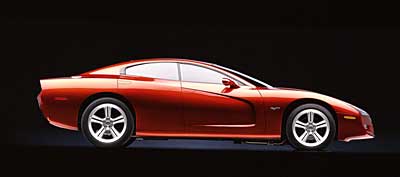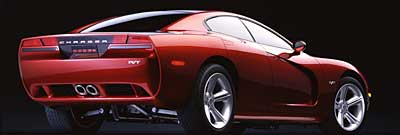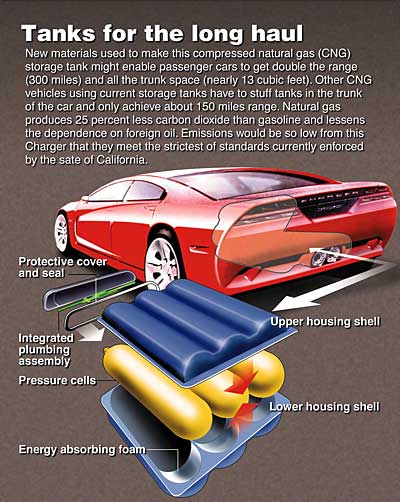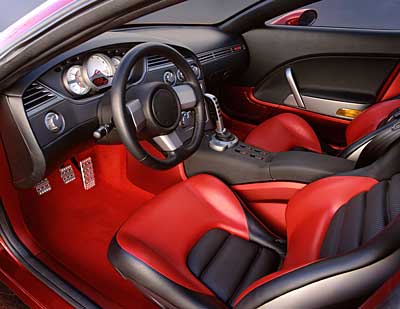|
|

|
Muscle Car Era Meets Future Technology in
New Concept Dodge Charger
The Dodge Charger R/T concept car allows you to "cruise" your favorite strip without any of the guilt.
While paying homage to the muscle car era, Charger R/T produces emissions so low it would meet the California Air
Resources Board Ultra Low Emission Vehicle (ULEV) standard. It would also reduce carbon dioxide emissions by
up to 25 percent. That's because this Charger R/T is powered by a upercharged, compressed natural gas (CNG) 4.7-liter V-8 engine.
Not only is this powertrain clean, but it generates 325 horsepower, blending both power and ultra low emissions.
While making an important statement for CNG technology, the Charger R/T was equally appealing to the design community.
"This is such a natural project for us," said Neil Walling, Vice President, Advanced Design and Exterior Large Car,
Small Car and Minivan Design.
"We had the opportunity to pay homage to a classic design from our past while updating it for the future."
|

|
|
One other major change distinguishes the concept from the original Charger of the mid-1960s-the concept has four doors.
"We originally sketched it with two doors, but the more we looked at it, we couldn't ignore the opportunity it presented for four doors," Walling said.
"Two-door sports coupe sales are shrinking and we don't see them rebounding soon. Cars such as our all-new Dodge Intrepid have shown we can build a sedan with coupe styling.
"Besides, anyone under 30 has grown up with four doors and is quite comfortable with them."
Joe Dehner, responsible for the exterior design, believes the
Charger R/T concept has just the right mean streak to
complement its performance features and V-8 power.
|

|
|
"It has muscular lines that are more exaggerated because of
the package, with big offset shoulders over the rear wheels,"
Dehner said. "This Charger R/T has a menacing look to the
front end, low and wide, and a powerful looking rear end.
Some aspects remind me of the Dodge Viper."
It has functional side scoops, as does the Viper, and the
chrome plated, central mounted exhaust is somewhat
reminiscent of Viper. It even has functional air exhausters
sculpted into its rear fascia.
"The original Charger had two non-functional scoops
stamped into its hood whereas we have one real scoop at the
leading edge of the hood, closest to the front grille," Dehner
added.
"The early sketches had that distinctive Charger grille, as if
the car swallowed a very wide harmonica. We even played
around with the bumblebee stripe around the rear end. But
we went away from that to a more modern, fresher
statement. Even the signature flying buttress, the body panel
that trims the rear window and tapers into the rear decklid,
resembles today's Intrepid more than the original Charger.
"If you look at the vehicle from the side you can still see
character lines that remind you of that 1960s CokeŽ bottle
look, but this car has full forms. The muscle cars were pretty
flat and wide in the front."
|

|
|
The Charger R/T is equally important for what it says about
CNG technology. The concept car showcases a new storage
tank system that one day might deliver 300 miles range in a
CNG-powered passenger car and not compromise storage
space in the trunk.
"Because of the size and design limitations of past CNG
storage tanks, thetechnology was best suited to full-size
vans," said Bernard Robertson, Senior Vice
President-Engineering Technologies and General
Manager-Truck Operations. "This breakthrough in
packaging allows us some freedom. We could reasonably
consider all vehicle segments, even sports cars some day.
Storage tank costs continue to be a hurdle for retail
applications, but CNG will become an even more viable
alternative for fleet customers."
A demonstration Plymouth Breeze is currently getting 320
miles range using this storage tank technology, which is
equivalent to 12.4 gallons of gasoline. The CNG Breeze also
has 12.5 cubic feet of trunk space compared to 15.7 cubic
feet of trunk space in the current production Breeze.
This technology innovation is the result of a collaboration
of the U.S. Department of Energy Office of Advanced
Automotive Technology, DaimlerChrysler, Siemens
Automotive and Johns Hopkins University's Applied
Physics Laboratory.
CNG storage tanks cost about $2,500 compared to $50-100
for a conventional tank for a gasoline engine. But the cost
of CNG tanks is coming down. Just five years ago, CNG
tanks cost about $5,000 to make. Federal and state
incentives eliminate that cost penalty in some markets.
The cylinders, or pressure cells, inside the Fiberglas storage
tank are lined with a gas-impermeable High Density
Polyurethane (HDPE) thermoplastic and wrapped in a
hybrid mix of high-strength carbon and super-tough glass
filaments that are wound with an epoxy resin. Finally, the
cylinders are laid into a "foam egg crate" to absorb impacts.
It's strong for its weight, resistant to environmental damage,
reliable and durable. The tank can be made flat, in the shape
of a conventional gasoline tank, yet the fuel can still be
stored at 3,600 pounds per square inch.
The former Chrysler Corporation had a long history in
CNG firsts. Chrysler was the first company to offer CNG
vehicles that met a series of increasingly tighter emissions
standards-Transitional Low Emission Vehicles (TLEV), Low
Emission Vehicles (LEV), Ultra-Low Emission Vehicles
(ULEV) and Inherently Low Emission Vehicles (ILEV).
Chrysler re-entered the natural gas vehicle market last fall
with two even cleaner models-the Super Ultra Low Emission
Vehicle (SULEV) Dodge Ram Van and Wagon.
|

|
|
While the exterior has a bad case of nasty attitude and the
engine enough "horses" to whet the appetite of Mopar
enthusiasts, the interior resembles a sophisticated fighter
plane cockpit, according to Interior Designer Lance Wagner.
The pistol grip shifter knob resembles a fighter pilot's
joystick and the instrument panel cluster is oriented to the
driver, with the tachometer being the dominant gauge.
"That cockpit look is balanced with some late 1960s cues,
such as the big rotary radio dials, the three-spoke steering
wheel and the R/T badge over the glove compartment,"
Wagner said.
The Charger R/T red sheet metal is exposed on the lower
door sills and the sidewalls of the center console. Even the
seat's support structure is exposed around the shoulders to
appear as if it's made of stamped aluminum. The black
carbon fiber performance bucket seats are accented with red
leather inserts. Even the accelerator, brake and clutch pedals
scream race car because of their smooth, machined,
lightweight look, Wagner added.
Aluminum silver armor accents the instrument panel,
interior door handles, floor pedals and armrest. The racing
look is completed with an integrated roll bar and rear
bucket seats.
This concept Charger R/T, while sharing the long nose and
rearward cab of the original, is a good deal shorter. It's 187
inches in overall length compared to 203 inches for the 1966
Charger. It's also lighter; 3,000 pounds versus 3,650 pounds.
The concept Charger R/T bears a family resemblance to the
Intrepid, but is 15 inches shorter. The exterior is Charger
Red, "a deep, liquid shade with a hint of yellow," Walling
added, with a black and red leather interior.
Charger R/T has a north-south front engine/transmission
layout, but is a rear-wheel-drive. It's mated to a five-speed
manual transfer case. The brakes come from the Dodge
Viper with 4-piston calipers in the front and 2-piston
calipers in the back. The upper and lower rear suspension
control arms are modified from the Plymouth Prowler.
The Dodge street machine features five-spoke cast aluminum
wheels; 19 inches in the front and 20 inches in the rear.
Goodyear's extended mobility tires are P245/45R19 in the
front and P295/40R20 in the rear.
|
|
|
|
|